Final Accounts: Sole Trader & Partnership Businesses - Analysis
VerifiedAdded on 2021/01/01
|16
|4335
|418
Report
AI Summary
This report provides a comprehensive overview of preparing final accounts for sole proprietorships and partnerships. It begins by identifying the reasons for closing accounts and preparing a trial balance, detailing the process of creating final accounts from a trial balance, and describing methods for constructing accounts from incomplete records. The report also addresses imbalances resulting from incorrect double entries and incomplete data. Task 2 focuses on preparing accounting records from incomplete information, calculating cash/bank balances, and preparing sales and purchase ledger control accounts. Task 3 covers the components of final accounts for sole traders, including profit and loss representation and balance sheet preparation. Tasks 4, 5, and 6 delve into partnership accounting, explaining partnership agreements, components of partnership accounts, profit and loss appropriation, profit determination, and the representation of partners' capital and current accounts, concluding with the measurement of closing balances and balance sheet presentation. The report aims to provide a detailed understanding of financial accounting principles for both sole traders and partnerships.
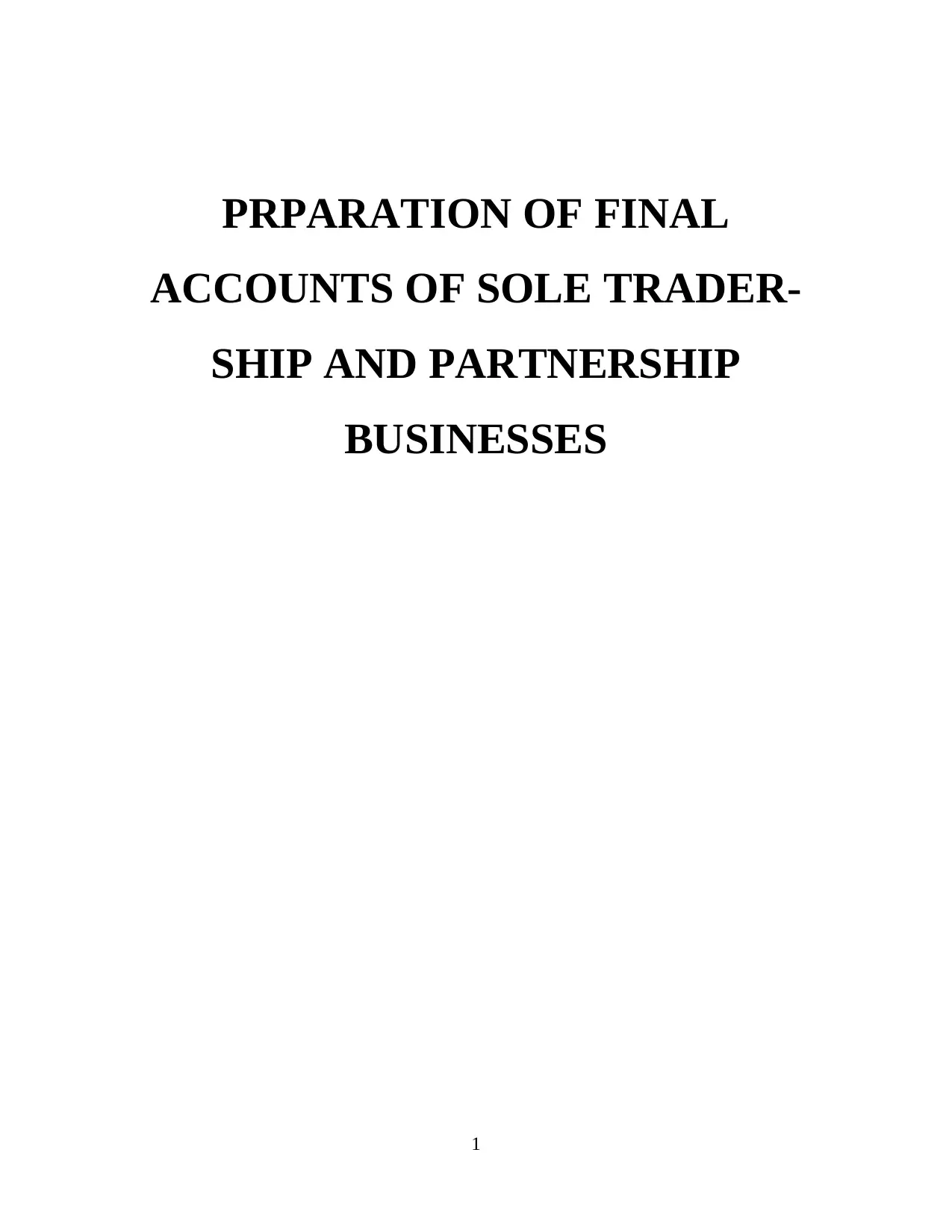
PRPARATION OF FINAL
ACCOUNTS OF SOLE TRADER-
SHIP AND PARTNERSHIP
BUSINESSES
1
ACCOUNTS OF SOLE TRADER-
SHIP AND PARTNERSHIP
BUSINESSES
1
Paraphrase This Document
Need a fresh take? Get an instant paraphrase of this document with our AI Paraphraser

Table of Contents
INTRODUCTION...........................................................................................................................3
TASK 1............................................................................................................................................3
1.1 Identifying the reasons behind the closing off accounts and preparation of trial balance ....3
1.2 Explanation of the process of preparing the final accounts on the basis of trial balance .....3
1.3 Describing the methods of constructing accounts from incomplete records.........................4
1.4 Reasons behind imbalances resulting from incorrect double entries.....................................4
1.5 Describing results of incomplete records arising from incomplete and inconsistent data ...5
TASK 2............................................................................................................................................5
2.1 Preparation of accounting records from incomplete information..........................................5
2.2 Calculation of opening/closing cash/bank account balance...................................................6
2.3 Preparation of sales and purchase ledger control accounts....................................................7
TASK 3............................................................................................................................................7
3.1 Components of final accounts of the sole trader....................................................................7
3.2 Representation of profit and loss accounts according to the given information ...................8
3.3 Representation of the balance sheet as per the given information ........................................9
TASK 4..........................................................................................................................................10
4.1 Explanation regarding the key elements of a partnership agreement..................................10
4.2 Explanation regarding the key components of partnership accounts...................................10
TASK 5..........................................................................................................................................12
5.1 Preparation of profit and loss appropriation account for the partnership firm....................12
5.2 Determination of profits of partners profits.........................................................................13
5.3 Representation of partners current and capital accounts......................................................13
TASK 6..........................................................................................................................................14
6.1 & 6.2 Measuring the closing balance on each partner’s current and capital account which
includes drawings and presenting balance sheet in compliance to partnership agreements......14
CONCLUSION..............................................................................................................................15
REFERENCES..............................................................................................................................16
2
INTRODUCTION...........................................................................................................................3
TASK 1............................................................................................................................................3
1.1 Identifying the reasons behind the closing off accounts and preparation of trial balance ....3
1.2 Explanation of the process of preparing the final accounts on the basis of trial balance .....3
1.3 Describing the methods of constructing accounts from incomplete records.........................4
1.4 Reasons behind imbalances resulting from incorrect double entries.....................................4
1.5 Describing results of incomplete records arising from incomplete and inconsistent data ...5
TASK 2............................................................................................................................................5
2.1 Preparation of accounting records from incomplete information..........................................5
2.2 Calculation of opening/closing cash/bank account balance...................................................6
2.3 Preparation of sales and purchase ledger control accounts....................................................7
TASK 3............................................................................................................................................7
3.1 Components of final accounts of the sole trader....................................................................7
3.2 Representation of profit and loss accounts according to the given information ...................8
3.3 Representation of the balance sheet as per the given information ........................................9
TASK 4..........................................................................................................................................10
4.1 Explanation regarding the key elements of a partnership agreement..................................10
4.2 Explanation regarding the key components of partnership accounts...................................10
TASK 5..........................................................................................................................................12
5.1 Preparation of profit and loss appropriation account for the partnership firm....................12
5.2 Determination of profits of partners profits.........................................................................13
5.3 Representation of partners current and capital accounts......................................................13
TASK 6..........................................................................................................................................14
6.1 & 6.2 Measuring the closing balance on each partner’s current and capital account which
includes drawings and presenting balance sheet in compliance to partnership agreements......14
CONCLUSION..............................................................................................................................15
REFERENCES..............................................................................................................................16
2
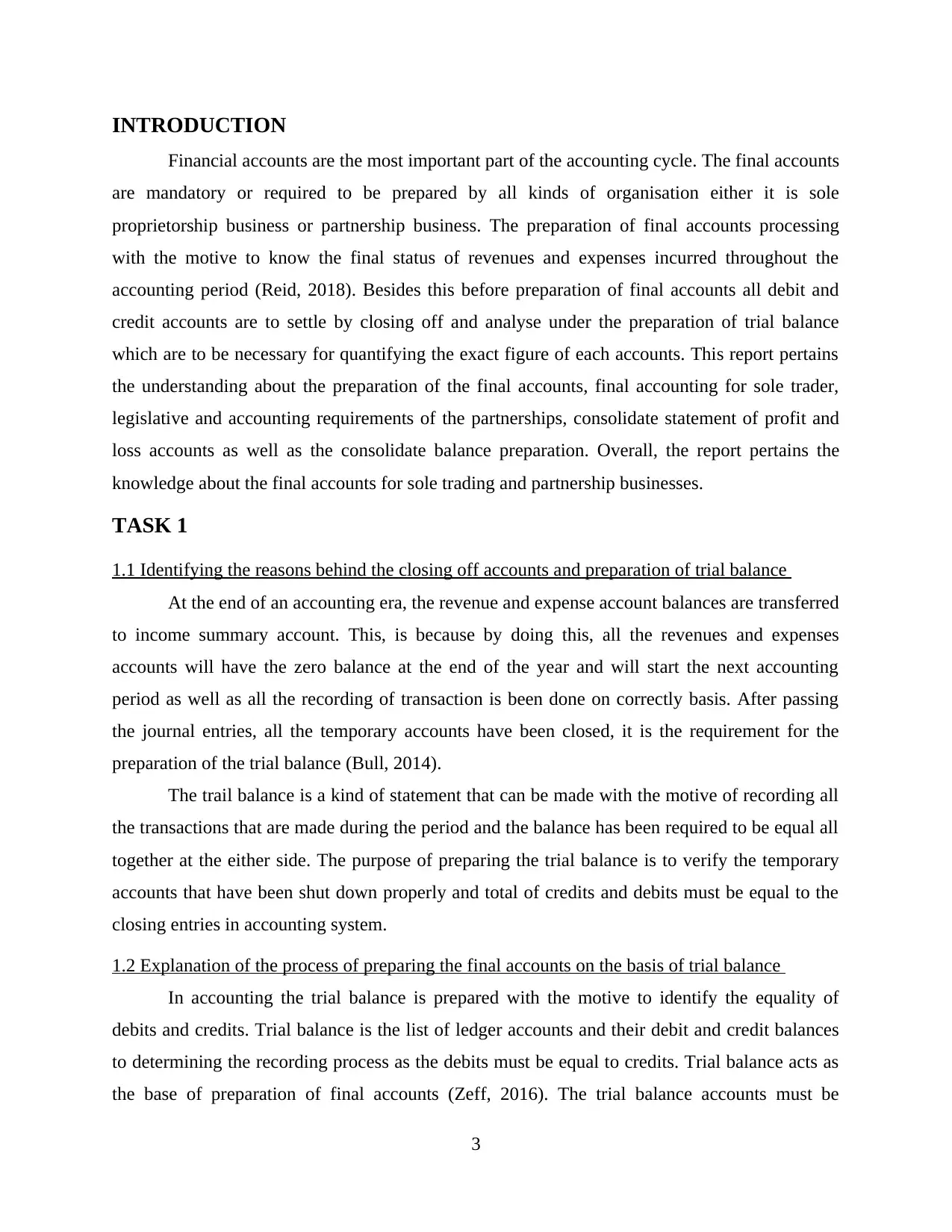
INTRODUCTION
Financial accounts are the most important part of the accounting cycle. The final accounts
are mandatory or required to be prepared by all kinds of organisation either it is sole
proprietorship business or partnership business. The preparation of final accounts processing
with the motive to know the final status of revenues and expenses incurred throughout the
accounting period (Reid, 2018). Besides this before preparation of final accounts all debit and
credit accounts are to settle by closing off and analyse under the preparation of trial balance
which are to be necessary for quantifying the exact figure of each accounts. This report pertains
the understanding about the preparation of the final accounts, final accounting for sole trader,
legislative and accounting requirements of the partnerships, consolidate statement of profit and
loss accounts as well as the consolidate balance preparation. Overall, the report pertains the
knowledge about the final accounts for sole trading and partnership businesses.
TASK 1
1.1 Identifying the reasons behind the closing off accounts and preparation of trial balance
At the end of an accounting era, the revenue and expense account balances are transferred
to income summary account. This, is because by doing this, all the revenues and expenses
accounts will have the zero balance at the end of the year and will start the next accounting
period as well as all the recording of transaction is been done on correctly basis. After passing
the journal entries, all the temporary accounts have been closed, it is the requirement for the
preparation of the trial balance (Bull, 2014).
The trail balance is a kind of statement that can be made with the motive of recording all
the transactions that are made during the period and the balance has been required to be equal all
together at the either side. The purpose of preparing the trial balance is to verify the temporary
accounts that have been shut down properly and total of credits and debits must be equal to the
closing entries in accounting system.
1.2 Explanation of the process of preparing the final accounts on the basis of trial balance
In accounting the trial balance is prepared with the motive to identify the equality of
debits and credits. Trial balance is the list of ledger accounts and their debit and credit balances
to determining the recording process as the debits must be equal to credits. Trial balance acts as
the base of preparation of final accounts (Zeff, 2016). The trial balance accounts must be
3
Financial accounts are the most important part of the accounting cycle. The final accounts
are mandatory or required to be prepared by all kinds of organisation either it is sole
proprietorship business or partnership business. The preparation of final accounts processing
with the motive to know the final status of revenues and expenses incurred throughout the
accounting period (Reid, 2018). Besides this before preparation of final accounts all debit and
credit accounts are to settle by closing off and analyse under the preparation of trial balance
which are to be necessary for quantifying the exact figure of each accounts. This report pertains
the understanding about the preparation of the final accounts, final accounting for sole trader,
legislative and accounting requirements of the partnerships, consolidate statement of profit and
loss accounts as well as the consolidate balance preparation. Overall, the report pertains the
knowledge about the final accounts for sole trading and partnership businesses.
TASK 1
1.1 Identifying the reasons behind the closing off accounts and preparation of trial balance
At the end of an accounting era, the revenue and expense account balances are transferred
to income summary account. This, is because by doing this, all the revenues and expenses
accounts will have the zero balance at the end of the year and will start the next accounting
period as well as all the recording of transaction is been done on correctly basis. After passing
the journal entries, all the temporary accounts have been closed, it is the requirement for the
preparation of the trial balance (Bull, 2014).
The trail balance is a kind of statement that can be made with the motive of recording all
the transactions that are made during the period and the balance has been required to be equal all
together at the either side. The purpose of preparing the trial balance is to verify the temporary
accounts that have been shut down properly and total of credits and debits must be equal to the
closing entries in accounting system.
1.2 Explanation of the process of preparing the final accounts on the basis of trial balance
In accounting the trial balance is prepared with the motive to identify the equality of
debits and credits. Trial balance is the list of ledger accounts and their debit and credit balances
to determining the recording process as the debits must be equal to credits. Trial balance acts as
the base of preparation of final accounts (Zeff, 2016). The trial balance accounts must be
3
⊘ This is a preview!⊘
Do you want full access?
Subscribe today to unlock all pages.

Trusted by 1+ million students worldwide
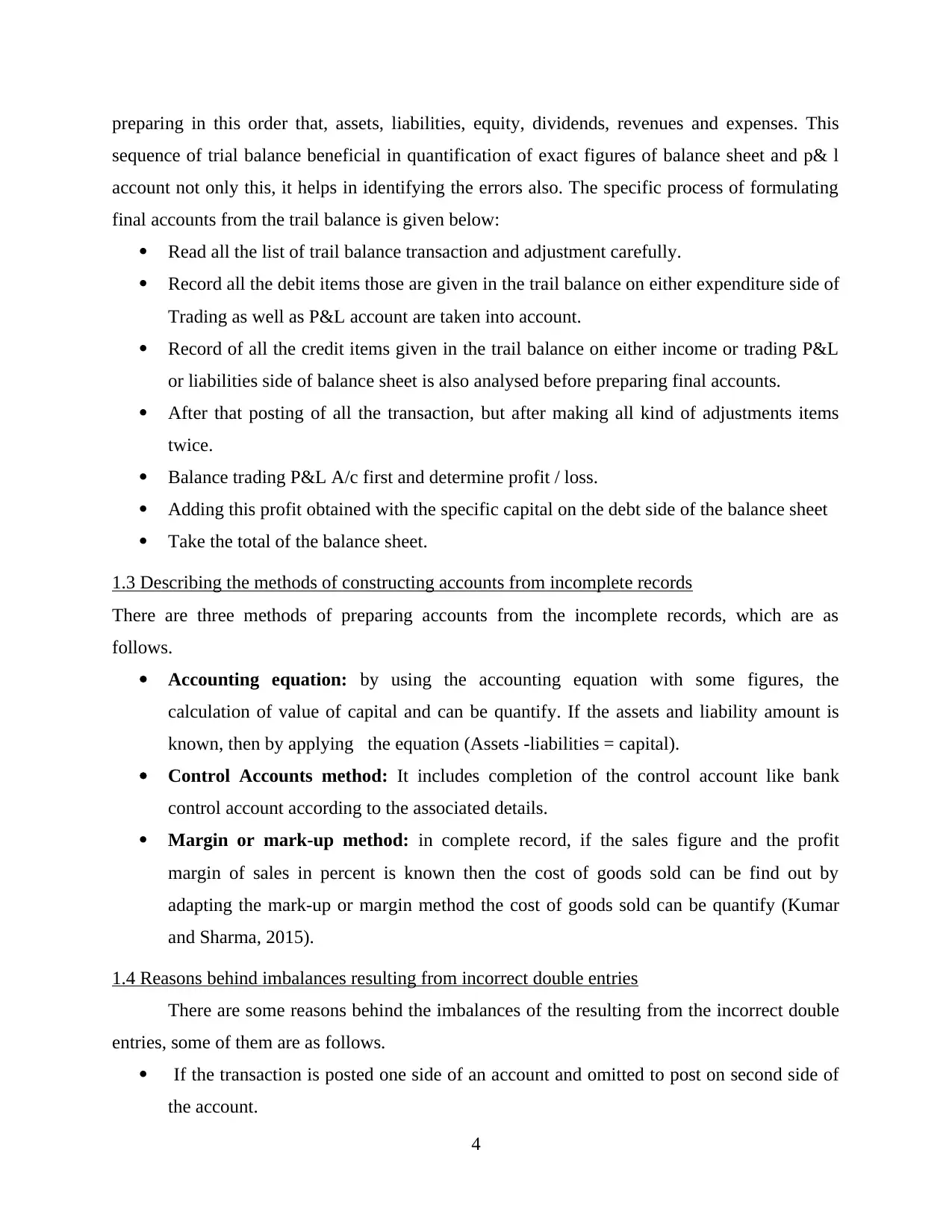
preparing in this order that, assets, liabilities, equity, dividends, revenues and expenses. This
sequence of trial balance beneficial in quantification of exact figures of balance sheet and p& l
account not only this, it helps in identifying the errors also. The specific process of formulating
final accounts from the trail balance is given below:
Read all the list of trail balance transaction and adjustment carefully.
Record all the debit items those are given in the trail balance on either expenditure side of
Trading as well as P&L account are taken into account.
Record of all the credit items given in the trail balance on either income or trading P&L
or liabilities side of balance sheet is also analysed before preparing final accounts.
After that posting of all the transaction, but after making all kind of adjustments items
twice.
Balance trading P&L A/c first and determine profit / loss.
Adding this profit obtained with the specific capital on the debt side of the balance sheet
Take the total of the balance sheet.
1.3 Describing the methods of constructing accounts from incomplete records
There are three methods of preparing accounts from the incomplete records, which are as
follows.
Accounting equation: by using the accounting equation with some figures, the
calculation of value of capital and can be quantify. If the assets and liability amount is
known, then by applying the equation (Assets -liabilities = capital).
Control Accounts method: It includes completion of the control account like bank
control account according to the associated details.
Margin or mark-up method: in complete record, if the sales figure and the profit
margin of sales in percent is known then the cost of goods sold can be find out by
adapting the mark-up or margin method the cost of goods sold can be quantify (Kumar
and Sharma, 2015).
1.4 Reasons behind imbalances resulting from incorrect double entries
There are some reasons behind the imbalances of the resulting from the incorrect double
entries, some of them are as follows.
If the transaction is posted one side of an account and omitted to post on second side of
the account.
4
sequence of trial balance beneficial in quantification of exact figures of balance sheet and p& l
account not only this, it helps in identifying the errors also. The specific process of formulating
final accounts from the trail balance is given below:
Read all the list of trail balance transaction and adjustment carefully.
Record all the debit items those are given in the trail balance on either expenditure side of
Trading as well as P&L account are taken into account.
Record of all the credit items given in the trail balance on either income or trading P&L
or liabilities side of balance sheet is also analysed before preparing final accounts.
After that posting of all the transaction, but after making all kind of adjustments items
twice.
Balance trading P&L A/c first and determine profit / loss.
Adding this profit obtained with the specific capital on the debt side of the balance sheet
Take the total of the balance sheet.
1.3 Describing the methods of constructing accounts from incomplete records
There are three methods of preparing accounts from the incomplete records, which are as
follows.
Accounting equation: by using the accounting equation with some figures, the
calculation of value of capital and can be quantify. If the assets and liability amount is
known, then by applying the equation (Assets -liabilities = capital).
Control Accounts method: It includes completion of the control account like bank
control account according to the associated details.
Margin or mark-up method: in complete record, if the sales figure and the profit
margin of sales in percent is known then the cost of goods sold can be find out by
adapting the mark-up or margin method the cost of goods sold can be quantify (Kumar
and Sharma, 2015).
1.4 Reasons behind imbalances resulting from incorrect double entries
There are some reasons behind the imbalances of the resulting from the incorrect double
entries, some of them are as follows.
If the transaction is posted one side of an account and omitted to post on second side of
the account.
4
Paraphrase This Document
Need a fresh take? Get an instant paraphrase of this document with our AI Paraphraser

If wrong amount is posted in ledger.
When amount is posted wrong side and sometimes the transaction is posted twice in
ledger accounts.
Omission to post the ledger balance also resulting from the incomplete entries.
1.5 Describing results of incomplete records arising from incomplete and inconsistent data
There are some results of incomplete records which are arises from the incomplete
records are as follows.
Lack of information regarding finalising financial statements (Steingold, 2017).
Information like sales, purchase, doubtful debts or depreciation etc.
Errors while recording transactions like omission, underacting or overcasting of ledger
accounts.
There is certain other reach such as errors in calculating equity and assets at the time of
revaluation.
TASK 2
2.1 Preparation of accounting records from incomplete information
(1) Given, the opening capital of ABC Ltd. is £1000, Drawing $600, the net Profit is £2600,
then the closing capital is?
According to the equation of incomplete records
profit/loss= capital at the end – cap. In beginning + Drawings of the year+ Capital
Introduced during the year
2600=closing capital-1000+600
2600=Closing capital-400
closing capital= 3000
Particulars Amount
Closing capital
add: drawings
less: capital at the beginning of the year
3000
600
(1000)
profit 2600
5
When amount is posted wrong side and sometimes the transaction is posted twice in
ledger accounts.
Omission to post the ledger balance also resulting from the incomplete entries.
1.5 Describing results of incomplete records arising from incomplete and inconsistent data
There are some results of incomplete records which are arises from the incomplete
records are as follows.
Lack of information regarding finalising financial statements (Steingold, 2017).
Information like sales, purchase, doubtful debts or depreciation etc.
Errors while recording transactions like omission, underacting or overcasting of ledger
accounts.
There is certain other reach such as errors in calculating equity and assets at the time of
revaluation.
TASK 2
2.1 Preparation of accounting records from incomplete information
(1) Given, the opening capital of ABC Ltd. is £1000, Drawing $600, the net Profit is £2600,
then the closing capital is?
According to the equation of incomplete records
profit/loss= capital at the end – cap. In beginning + Drawings of the year+ Capital
Introduced during the year
2600=closing capital-1000+600
2600=Closing capital-400
closing capital= 3000
Particulars Amount
Closing capital
add: drawings
less: capital at the beginning of the year
3000
600
(1000)
profit 2600
5
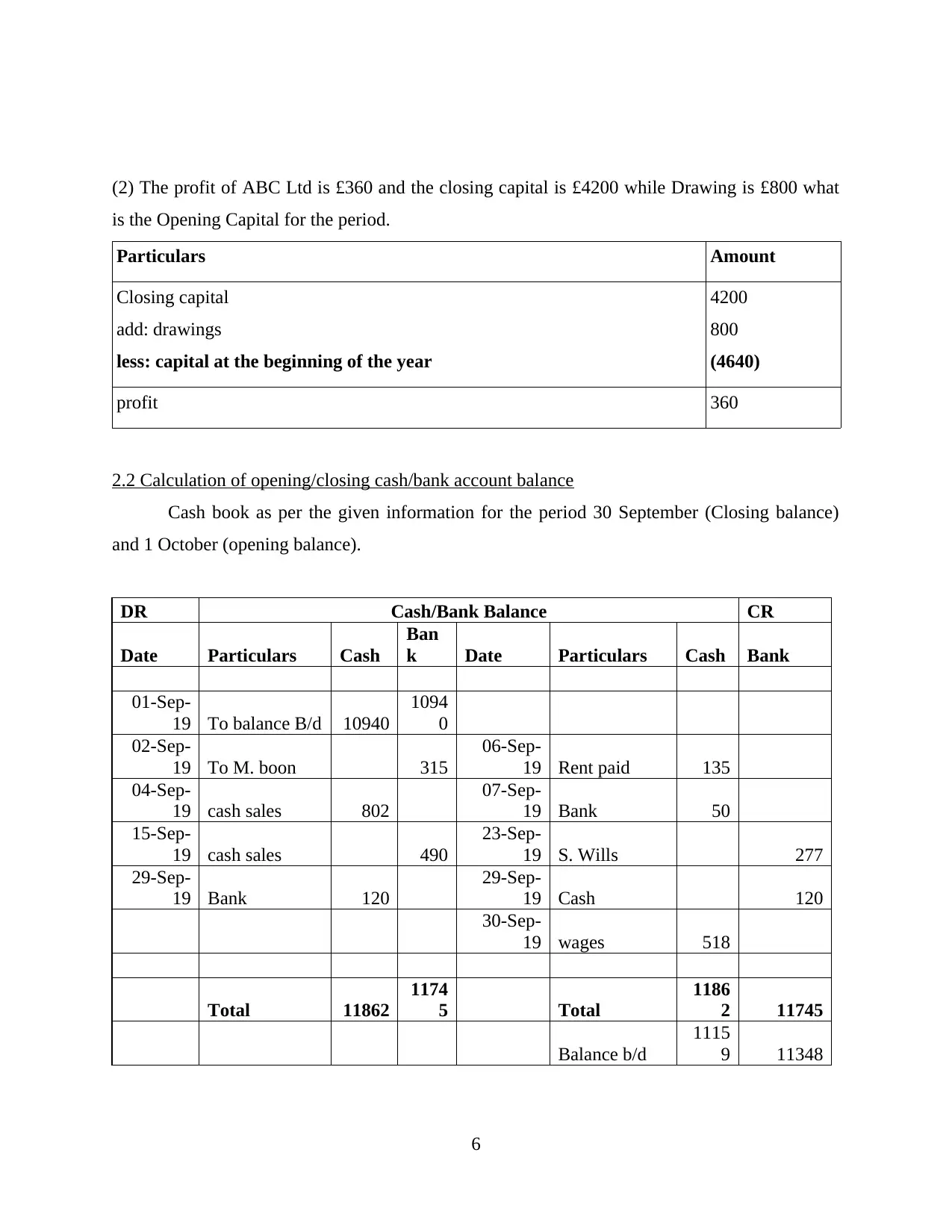
(2) The profit of ABC Ltd is £360 and the closing capital is £4200 while Drawing is £800 what
is the Opening Capital for the period.
Particulars Amount
Closing capital
add: drawings
less: capital at the beginning of the year
4200
800
(4640)
profit 360
2.2 Calculation of opening/closing cash/bank account balance
Cash book as per the given information for the period 30 September (Closing balance)
and 1 October (opening balance).
DR Cash/Bank Balance CR
Date Particulars Cash
Ban
k Date Particulars Cash Bank
01-Sep-
19 To balance B/d 10940
1094
0
02-Sep-
19 To M. boon 315
06-Sep-
19 Rent paid 135
04-Sep-
19 cash sales 802
07-Sep-
19 Bank 50
15-Sep-
19 cash sales 490
23-Sep-
19 S. Wills 277
29-Sep-
19 Bank 120
29-Sep-
19 Cash 120
30-Sep-
19 wages 518
Total 11862
1174
5 Total
1186
2 11745
Balance b/d
1115
9 11348
6
is the Opening Capital for the period.
Particulars Amount
Closing capital
add: drawings
less: capital at the beginning of the year
4200
800
(4640)
profit 360
2.2 Calculation of opening/closing cash/bank account balance
Cash book as per the given information for the period 30 September (Closing balance)
and 1 October (opening balance).
DR Cash/Bank Balance CR
Date Particulars Cash
Ban
k Date Particulars Cash Bank
01-Sep-
19 To balance B/d 10940
1094
0
02-Sep-
19 To M. boon 315
06-Sep-
19 Rent paid 135
04-Sep-
19 cash sales 802
07-Sep-
19 Bank 50
15-Sep-
19 cash sales 490
23-Sep-
19 S. Wills 277
29-Sep-
19 Bank 120
29-Sep-
19 Cash 120
30-Sep-
19 wages 518
Total 11862
1174
5 Total
1186
2 11745
Balance b/d
1115
9 11348
6
⊘ This is a preview!⊘
Do you want full access?
Subscribe today to unlock all pages.

Trusted by 1+ million students worldwide
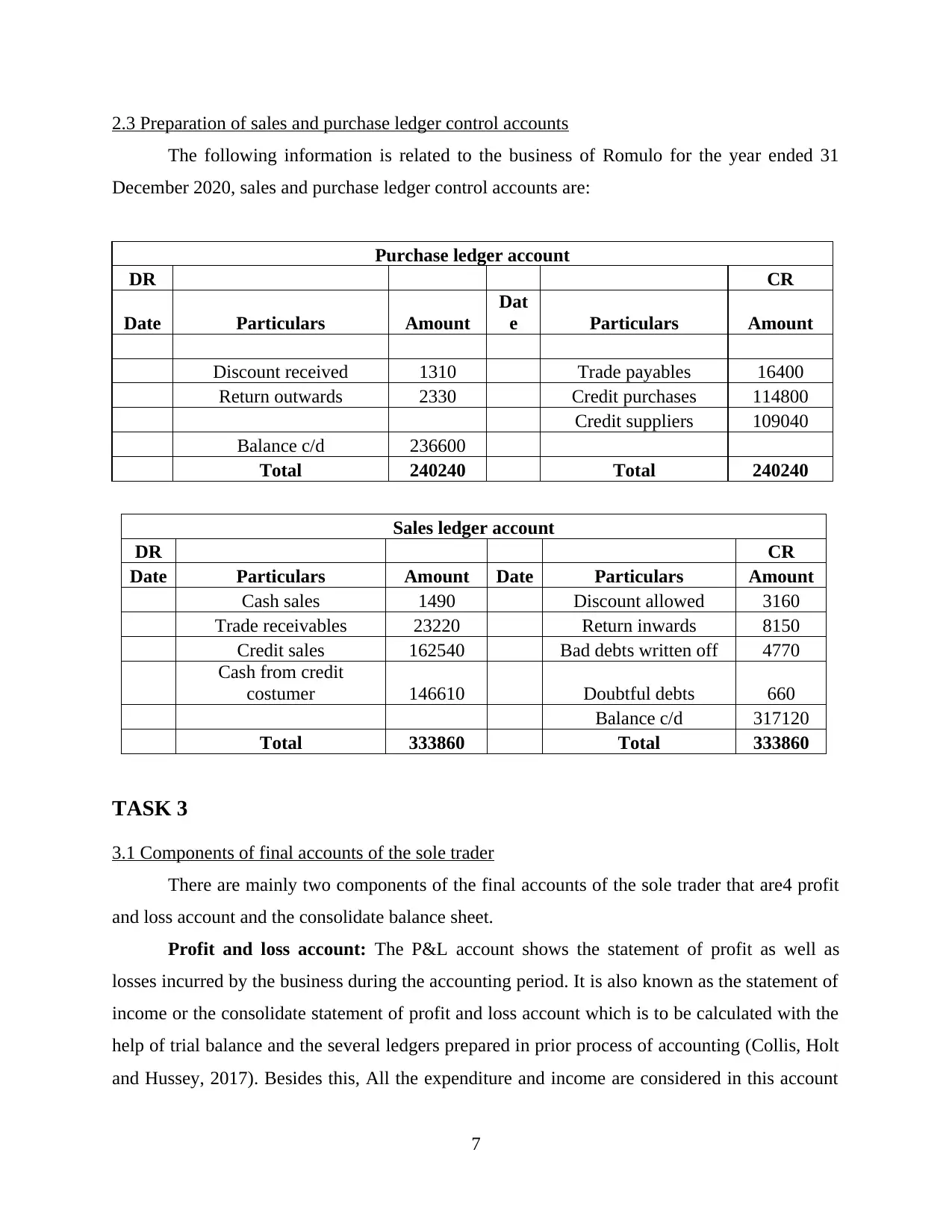
2.3 Preparation of sales and purchase ledger control accounts
The following information is related to the business of Romulo for the year ended 31
December 2020, sales and purchase ledger control accounts are:
Purchase ledger account
DR CR
Date Particulars Amount
Dat
e Particulars Amount
Discount received 1310 Trade payables 16400
Return outwards 2330 Credit purchases 114800
Credit suppliers 109040
Balance c/d 236600
Total 240240 Total 240240
Sales ledger account
DR CR
Date Particulars Amount Date Particulars Amount
Cash sales 1490 Discount allowed 3160
Trade receivables 23220 Return inwards 8150
Credit sales 162540 Bad debts written off 4770
Cash from credit
costumer 146610 Doubtful debts 660
Balance c/d 317120
Total 333860 Total 333860
TASK 3
3.1 Components of final accounts of the sole trader
There are mainly two components of the final accounts of the sole trader that are4 profit
and loss account and the consolidate balance sheet.
Profit and loss account: The P&L account shows the statement of profit as well as
losses incurred by the business during the accounting period. It is also known as the statement of
income or the consolidate statement of profit and loss account which is to be calculated with the
help of trial balance and the several ledgers prepared in prior process of accounting (Collis, Holt
and Hussey, 2017). Besides this, All the expenditure and income are considered in this account
7
The following information is related to the business of Romulo for the year ended 31
December 2020, sales and purchase ledger control accounts are:
Purchase ledger account
DR CR
Date Particulars Amount
Dat
e Particulars Amount
Discount received 1310 Trade payables 16400
Return outwards 2330 Credit purchases 114800
Credit suppliers 109040
Balance c/d 236600
Total 240240 Total 240240
Sales ledger account
DR CR
Date Particulars Amount Date Particulars Amount
Cash sales 1490 Discount allowed 3160
Trade receivables 23220 Return inwards 8150
Credit sales 162540 Bad debts written off 4770
Cash from credit
costumer 146610 Doubtful debts 660
Balance c/d 317120
Total 333860 Total 333860
TASK 3
3.1 Components of final accounts of the sole trader
There are mainly two components of the final accounts of the sole trader that are4 profit
and loss account and the consolidate balance sheet.
Profit and loss account: The P&L account shows the statement of profit as well as
losses incurred by the business during the accounting period. It is also known as the statement of
income or the consolidate statement of profit and loss account which is to be calculated with the
help of trial balance and the several ledgers prepared in prior process of accounting (Collis, Holt
and Hussey, 2017). Besides this, All the expenditure and income are considered in this account
7
Paraphrase This Document
Need a fresh take? Get an instant paraphrase of this document with our AI Paraphraser
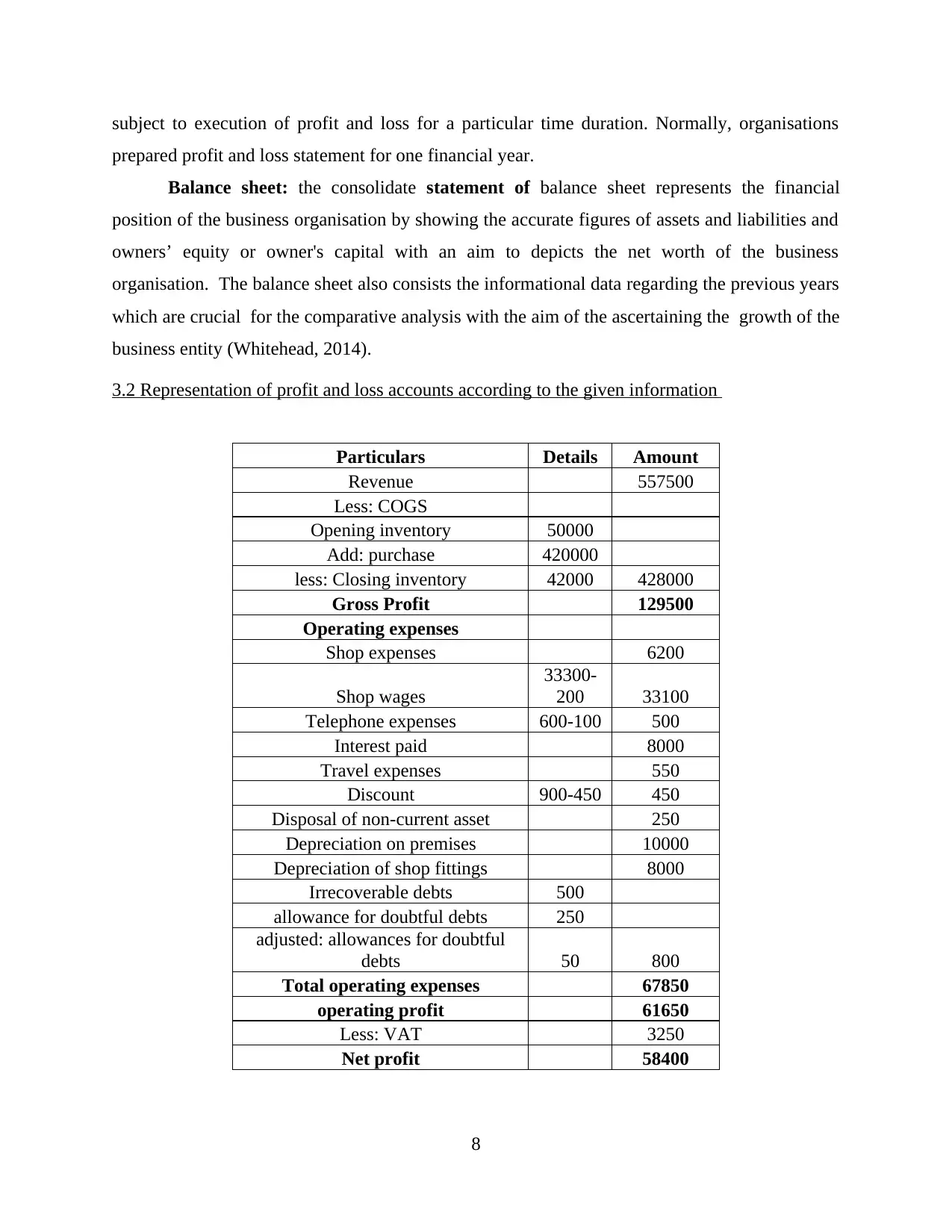
subject to execution of profit and loss for a particular time duration. Normally, organisations
prepared profit and loss statement for one financial year.
Balance sheet: the consolidate statement of balance sheet represents the financial
position of the business organisation by showing the accurate figures of assets and liabilities and
owners’ equity or owner's capital with an aim to depicts the net worth of the business
organisation. The balance sheet also consists the informational data regarding the previous years
which are crucial for the comparative analysis with the aim of the ascertaining the growth of the
business entity (Whitehead, 2014).
3.2 Representation of profit and loss accounts according to the given information
Particulars Details Amount
Revenue 557500
Less: COGS
Opening inventory 50000
Add: purchase 420000
less: Closing inventory 42000 428000
Gross Profit 129500
Operating expenses
Shop expenses 6200
Shop wages
33300-
200 33100
Telephone expenses 600-100 500
Interest paid 8000
Travel expenses 550
Discount 900-450 450
Disposal of non-current asset 250
Depreciation on premises 10000
Depreciation of shop fittings 8000
Irrecoverable debts 500
allowance for doubtful debts 250
adjusted: allowances for doubtful
debts 50 800
Total operating expenses 67850
operating profit 61650
Less: VAT 3250
Net profit 58400
8
prepared profit and loss statement for one financial year.
Balance sheet: the consolidate statement of balance sheet represents the financial
position of the business organisation by showing the accurate figures of assets and liabilities and
owners’ equity or owner's capital with an aim to depicts the net worth of the business
organisation. The balance sheet also consists the informational data regarding the previous years
which are crucial for the comparative analysis with the aim of the ascertaining the growth of the
business entity (Whitehead, 2014).
3.2 Representation of profit and loss accounts according to the given information
Particulars Details Amount
Revenue 557500
Less: COGS
Opening inventory 50000
Add: purchase 420000
less: Closing inventory 42000 428000
Gross Profit 129500
Operating expenses
Shop expenses 6200
Shop wages
33300-
200 33100
Telephone expenses 600-100 500
Interest paid 8000
Travel expenses 550
Discount 900-450 450
Disposal of non-current asset 250
Depreciation on premises 10000
Depreciation of shop fittings 8000
Irrecoverable debts 500
allowance for doubtful debts 250
adjusted: allowances for doubtful
debts 50 800
Total operating expenses 67850
operating profit 61650
Less: VAT 3250
Net profit 58400
8
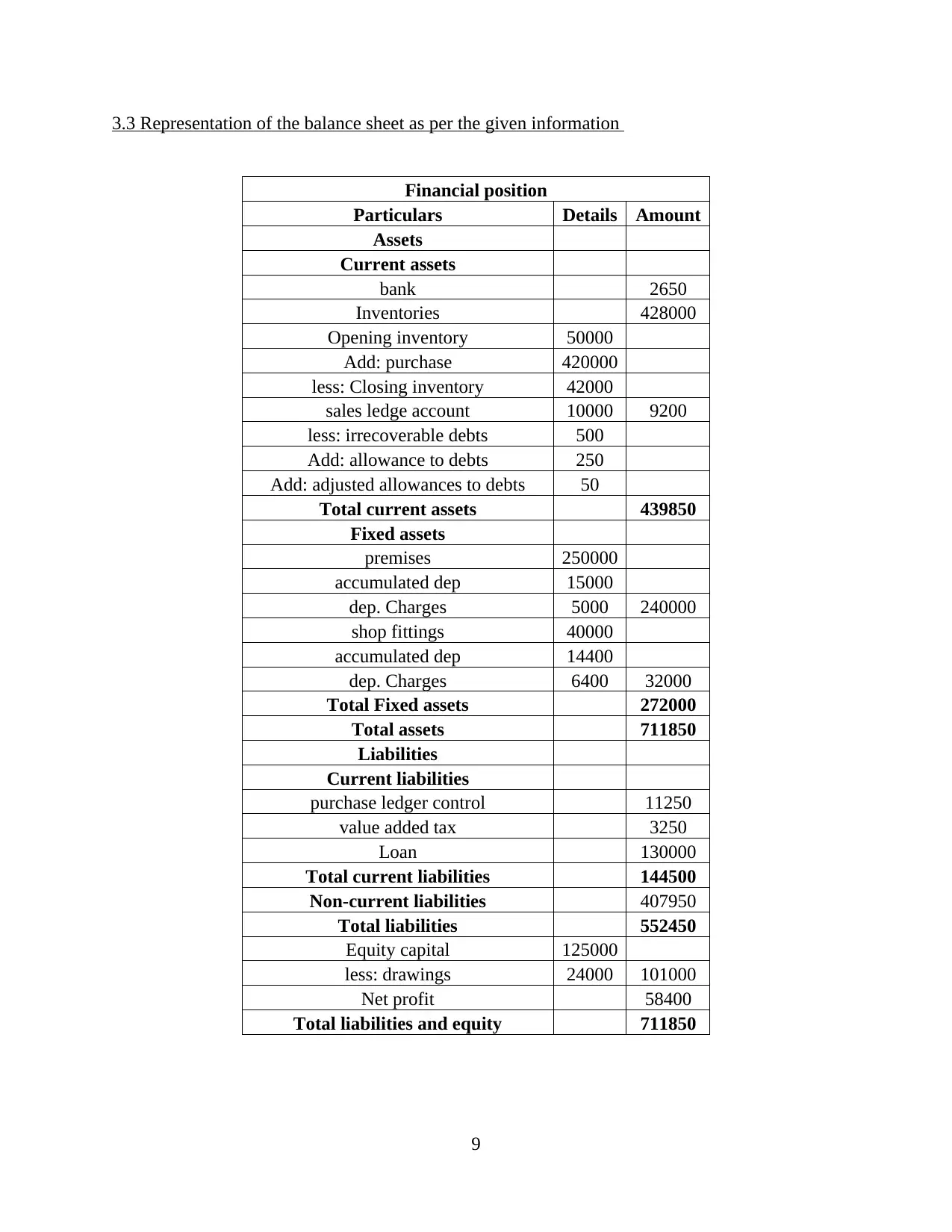
3.3 Representation of the balance sheet as per the given information
Financial position
Particulars Details Amount
Assets
Current assets
bank 2650
Inventories 428000
Opening inventory 50000
Add: purchase 420000
less: Closing inventory 42000
sales ledge account 10000 9200
less: irrecoverable debts 500
Add: allowance to debts 250
Add: adjusted allowances to debts 50
Total current assets 439850
Fixed assets
premises 250000
accumulated dep 15000
dep. Charges 5000 240000
shop fittings 40000
accumulated dep 14400
dep. Charges 6400 32000
Total Fixed assets 272000
Total assets 711850
Liabilities
Current liabilities
purchase ledger control 11250
value added tax 3250
Loan 130000
Total current liabilities 144500
Non-current liabilities 407950
Total liabilities 552450
Equity capital 125000
less: drawings 24000 101000
Net profit 58400
Total liabilities and equity 711850
9
Financial position
Particulars Details Amount
Assets
Current assets
bank 2650
Inventories 428000
Opening inventory 50000
Add: purchase 420000
less: Closing inventory 42000
sales ledge account 10000 9200
less: irrecoverable debts 500
Add: allowance to debts 250
Add: adjusted allowances to debts 50
Total current assets 439850
Fixed assets
premises 250000
accumulated dep 15000
dep. Charges 5000 240000
shop fittings 40000
accumulated dep 14400
dep. Charges 6400 32000
Total Fixed assets 272000
Total assets 711850
Liabilities
Current liabilities
purchase ledger control 11250
value added tax 3250
Loan 130000
Total current liabilities 144500
Non-current liabilities 407950
Total liabilities 552450
Equity capital 125000
less: drawings 24000 101000
Net profit 58400
Total liabilities and equity 711850
9
⊘ This is a preview!⊘
Do you want full access?
Subscribe today to unlock all pages.

Trusted by 1+ million students worldwide
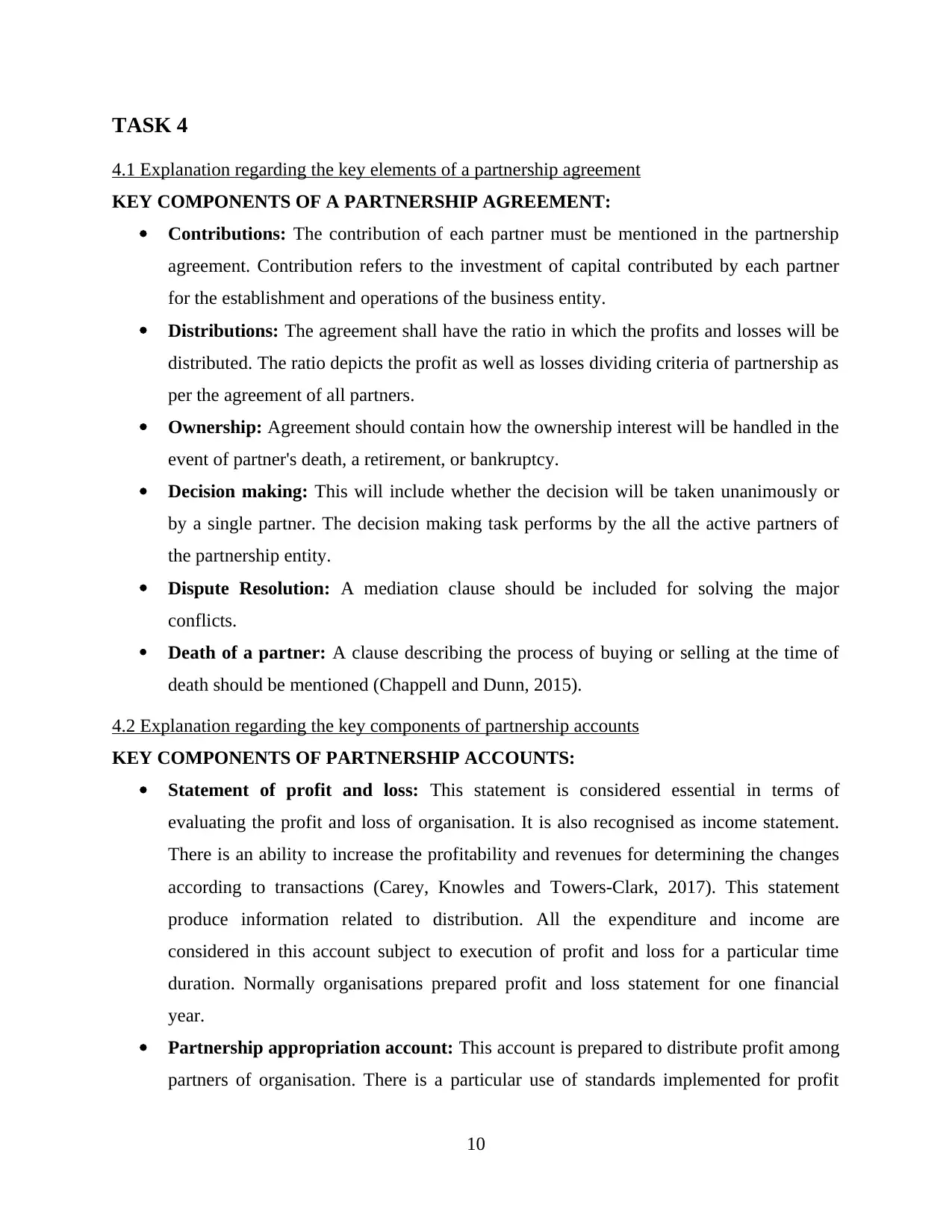
TASK 4
4.1 Explanation regarding the key elements of a partnership agreement
KEY COMPONENTS OF A PARTNERSHIP AGREEMENT:
Contributions: The contribution of each partner must be mentioned in the partnership
agreement. Contribution refers to the investment of capital contributed by each partner
for the establishment and operations of the business entity.
Distributions: The agreement shall have the ratio in which the profits and losses will be
distributed. The ratio depicts the profit as well as losses dividing criteria of partnership as
per the agreement of all partners.
Ownership: Agreement should contain how the ownership interest will be handled in the
event of partner's death, a retirement, or bankruptcy.
Decision making: This will include whether the decision will be taken unanimously or
by a single partner. The decision making task performs by the all the active partners of
the partnership entity.
Dispute Resolution: A mediation clause should be included for solving the major
conflicts.
Death of a partner: A clause describing the process of buying or selling at the time of
death should be mentioned (Chappell and Dunn, 2015).
4.2 Explanation regarding the key components of partnership accounts
KEY COMPONENTS OF PARTNERSHIP ACCOUNTS:
Statement of profit and loss: This statement is considered essential in terms of
evaluating the profit and loss of organisation. It is also recognised as income statement.
There is an ability to increase the profitability and revenues for determining the changes
according to transactions (Carey, Knowles and Towers-Clark, 2017). This statement
produce information related to distribution. All the expenditure and income are
considered in this account subject to execution of profit and loss for a particular time
duration. Normally organisations prepared profit and loss statement for one financial
year.
Partnership appropriation account: This account is prepared to distribute profit among
partners of organisation. There is a particular use of standards implemented for profit
10
4.1 Explanation regarding the key elements of a partnership agreement
KEY COMPONENTS OF A PARTNERSHIP AGREEMENT:
Contributions: The contribution of each partner must be mentioned in the partnership
agreement. Contribution refers to the investment of capital contributed by each partner
for the establishment and operations of the business entity.
Distributions: The agreement shall have the ratio in which the profits and losses will be
distributed. The ratio depicts the profit as well as losses dividing criteria of partnership as
per the agreement of all partners.
Ownership: Agreement should contain how the ownership interest will be handled in the
event of partner's death, a retirement, or bankruptcy.
Decision making: This will include whether the decision will be taken unanimously or
by a single partner. The decision making task performs by the all the active partners of
the partnership entity.
Dispute Resolution: A mediation clause should be included for solving the major
conflicts.
Death of a partner: A clause describing the process of buying or selling at the time of
death should be mentioned (Chappell and Dunn, 2015).
4.2 Explanation regarding the key components of partnership accounts
KEY COMPONENTS OF PARTNERSHIP ACCOUNTS:
Statement of profit and loss: This statement is considered essential in terms of
evaluating the profit and loss of organisation. It is also recognised as income statement.
There is an ability to increase the profitability and revenues for determining the changes
according to transactions (Carey, Knowles and Towers-Clark, 2017). This statement
produce information related to distribution. All the expenditure and income are
considered in this account subject to execution of profit and loss for a particular time
duration. Normally organisations prepared profit and loss statement for one financial
year.
Partnership appropriation account: This account is prepared to distribute profit among
partners of organisation. There is a particular use of standards implemented for profit
10
Paraphrase This Document
Need a fresh take? Get an instant paraphrase of this document with our AI Paraphraser

appropriation subject to income and profit and loss account. The distribution of the
residual income and the partner capital accounts are analysed in respect of different loans
and capital accounts (Arora, 2016). Main objective of partnership appropriation account
mainly analysed for distributing profit among partners without any concerns and
conflicts.
Goodwill: It is considered as an intangible assets of organisation that mainly define the
value of business in market. It is an item that is acquired by organisation subject to
analyse profitability of organisation. It is a sum of adjustment made between assets and
liabilities. The amount additionally paid to owners of existing company in excess of
assets are considered as goodwill amount.
Partner's current accounts: The current account is held by the partnership firm and it is
referring to the account used for crediting the profits and debiting the losses, interest on
partners’ capital and drawings. This accounts have lack of stability and fluctuated in
nature. When the fixed capital is contributed in the entity the adjustments associated with
the partners and entity like salary, fees, bonus, commission, interest on drawing, share in
losses all these are to be recorded in the account called current account. capital account.
The current account is opened for each partner separately when the capital amount is
fixed. The balance of this account fluctuates in every accounting period as well as the
balance can be of both natures that are credit or debit. Current accounts can be
maintained by the individual, partners, societies and companies (Bull, 2014).
Partner's capital accounts: The partner's capital account refers to the account which
records the partners invested capitals and drawings made by them. This account is not
fluctuating until the capital and the drawing made by the partner or the owner. This
account records the contribution of capitals made by each partners and drawings made by
each partners (Aghrout, 2018). It is that type of account which does not records the
transactions between the individual partner and the company. Besides this, the transaction
delta which is related with the contribution of fixed capital or withdraw of capital made
by the individual partners.
Statement of financial position: The statement which depicts the financial position of
the organisation is commonly known as the consolidate statement of balance sheet. It is
the statement which is prepared by the organisation at the end of the accounting period
11
residual income and the partner capital accounts are analysed in respect of different loans
and capital accounts (Arora, 2016). Main objective of partnership appropriation account
mainly analysed for distributing profit among partners without any concerns and
conflicts.
Goodwill: It is considered as an intangible assets of organisation that mainly define the
value of business in market. It is an item that is acquired by organisation subject to
analyse profitability of organisation. It is a sum of adjustment made between assets and
liabilities. The amount additionally paid to owners of existing company in excess of
assets are considered as goodwill amount.
Partner's current accounts: The current account is held by the partnership firm and it is
referring to the account used for crediting the profits and debiting the losses, interest on
partners’ capital and drawings. This accounts have lack of stability and fluctuated in
nature. When the fixed capital is contributed in the entity the adjustments associated with
the partners and entity like salary, fees, bonus, commission, interest on drawing, share in
losses all these are to be recorded in the account called current account. capital account.
The current account is opened for each partner separately when the capital amount is
fixed. The balance of this account fluctuates in every accounting period as well as the
balance can be of both natures that are credit or debit. Current accounts can be
maintained by the individual, partners, societies and companies (Bull, 2014).
Partner's capital accounts: The partner's capital account refers to the account which
records the partners invested capitals and drawings made by them. This account is not
fluctuating until the capital and the drawing made by the partner or the owner. This
account records the contribution of capitals made by each partners and drawings made by
each partners (Aghrout, 2018). It is that type of account which does not records the
transactions between the individual partner and the company. Besides this, the transaction
delta which is related with the contribution of fixed capital or withdraw of capital made
by the individual partners.
Statement of financial position: The statement which depicts the financial position of
the organisation is commonly known as the consolidate statement of balance sheet. It is
the statement which is prepared by the organisation at the end of the accounting period
11
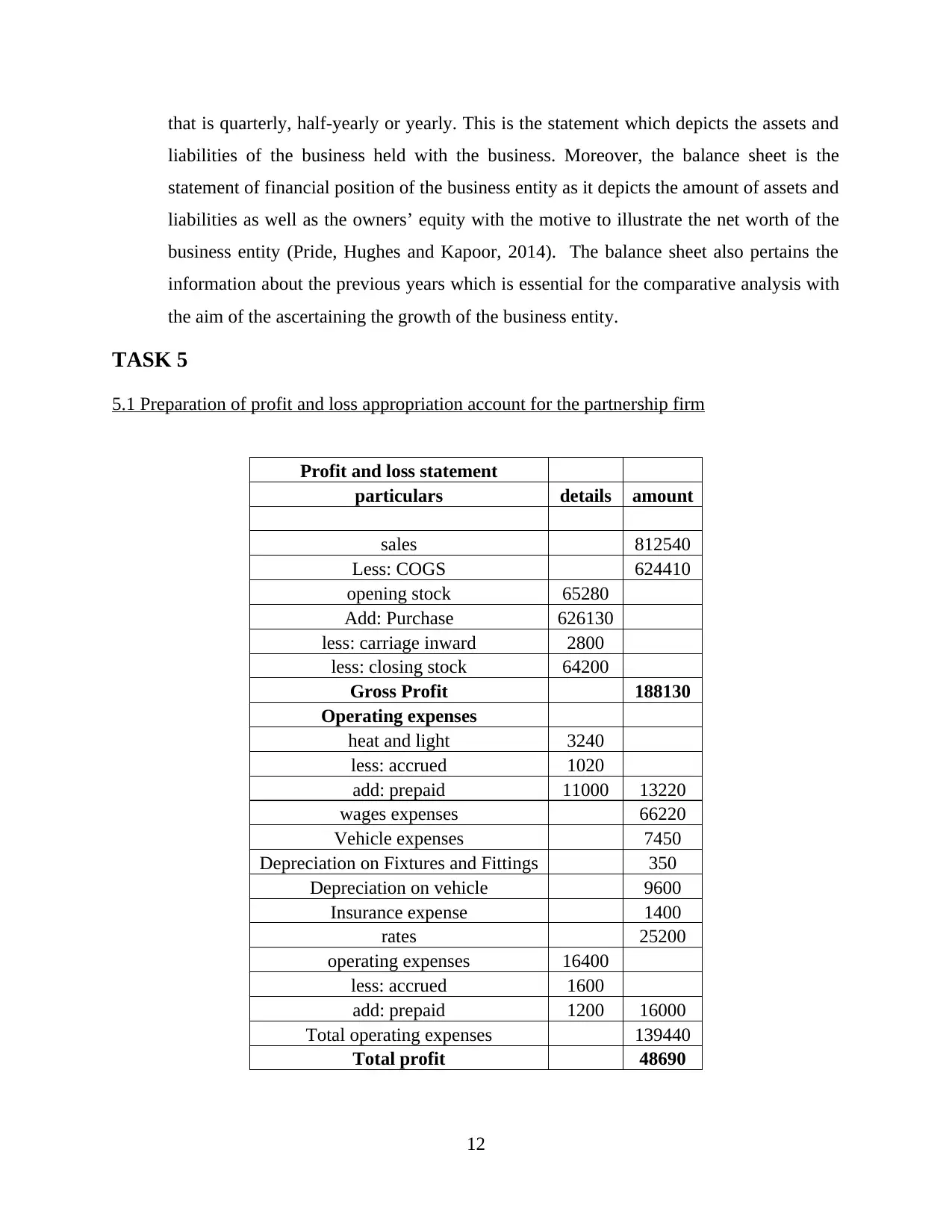
that is quarterly, half-yearly or yearly. This is the statement which depicts the assets and
liabilities of the business held with the business. Moreover, the balance sheet is the
statement of financial position of the business entity as it depicts the amount of assets and
liabilities as well as the owners’ equity with the motive to illustrate the net worth of the
business entity (Pride, Hughes and Kapoor, 2014). The balance sheet also pertains the
information about the previous years which is essential for the comparative analysis with
the aim of the ascertaining the growth of the business entity.
TASK 5
5.1 Preparation of profit and loss appropriation account for the partnership firm
Profit and loss statement
particulars details amount
sales 812540
Less: COGS 624410
opening stock 65280
Add: Purchase 626130
less: carriage inward 2800
less: closing stock 64200
Gross Profit 188130
Operating expenses
heat and light 3240
less: accrued 1020
add: prepaid 11000 13220
wages expenses 66220
Vehicle expenses 7450
Depreciation on Fixtures and Fittings 350
Depreciation on vehicle 9600
Insurance expense 1400
rates 25200
operating expenses 16400
less: accrued 1600
add: prepaid 1200 16000
Total operating expenses 139440
Total profit 48690
12
liabilities of the business held with the business. Moreover, the balance sheet is the
statement of financial position of the business entity as it depicts the amount of assets and
liabilities as well as the owners’ equity with the motive to illustrate the net worth of the
business entity (Pride, Hughes and Kapoor, 2014). The balance sheet also pertains the
information about the previous years which is essential for the comparative analysis with
the aim of the ascertaining the growth of the business entity.
TASK 5
5.1 Preparation of profit and loss appropriation account for the partnership firm
Profit and loss statement
particulars details amount
sales 812540
Less: COGS 624410
opening stock 65280
Add: Purchase 626130
less: carriage inward 2800
less: closing stock 64200
Gross Profit 188130
Operating expenses
heat and light 3240
less: accrued 1020
add: prepaid 11000 13220
wages expenses 66220
Vehicle expenses 7450
Depreciation on Fixtures and Fittings 350
Depreciation on vehicle 9600
Insurance expense 1400
rates 25200
operating expenses 16400
less: accrued 1600
add: prepaid 1200 16000
Total operating expenses 139440
Total profit 48690
12
⊘ This is a preview!⊘
Do you want full access?
Subscribe today to unlock all pages.

Trusted by 1+ million students worldwide
1 out of 16
Related Documents
Your All-in-One AI-Powered Toolkit for Academic Success.
+13062052269
info@desklib.com
Available 24*7 on WhatsApp / Email
![[object Object]](/_next/static/media/star-bottom.7253800d.svg)
Unlock your academic potential
Copyright © 2020–2025 A2Z Services. All Rights Reserved. Developed and managed by ZUCOL.





